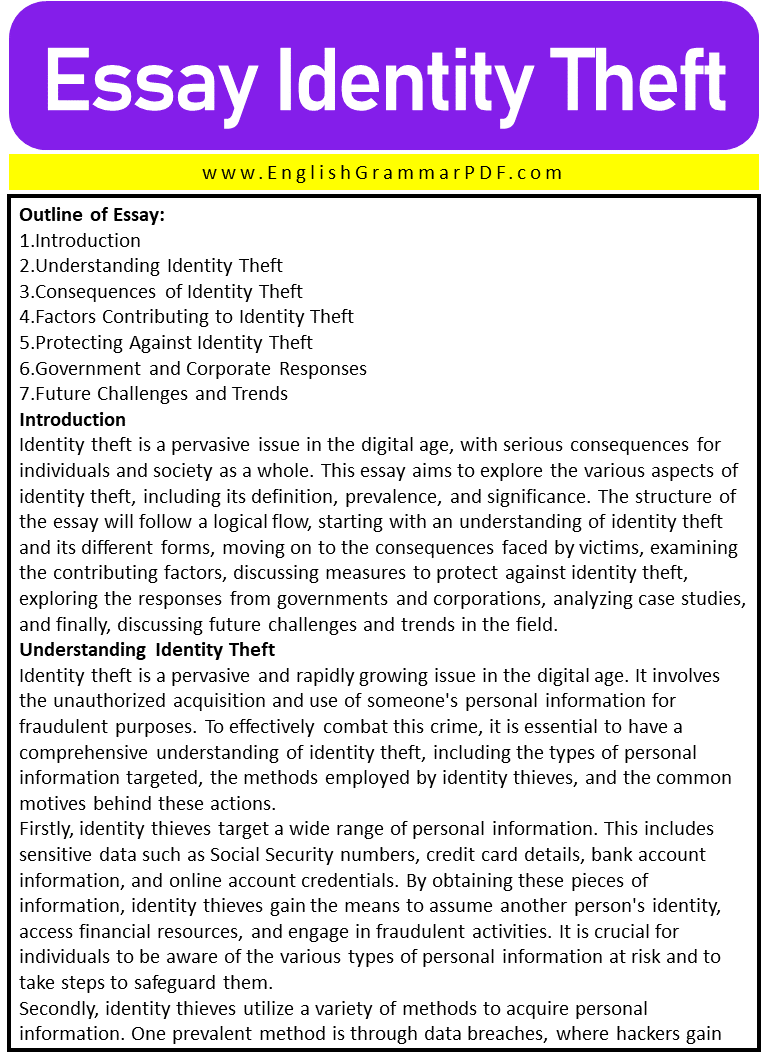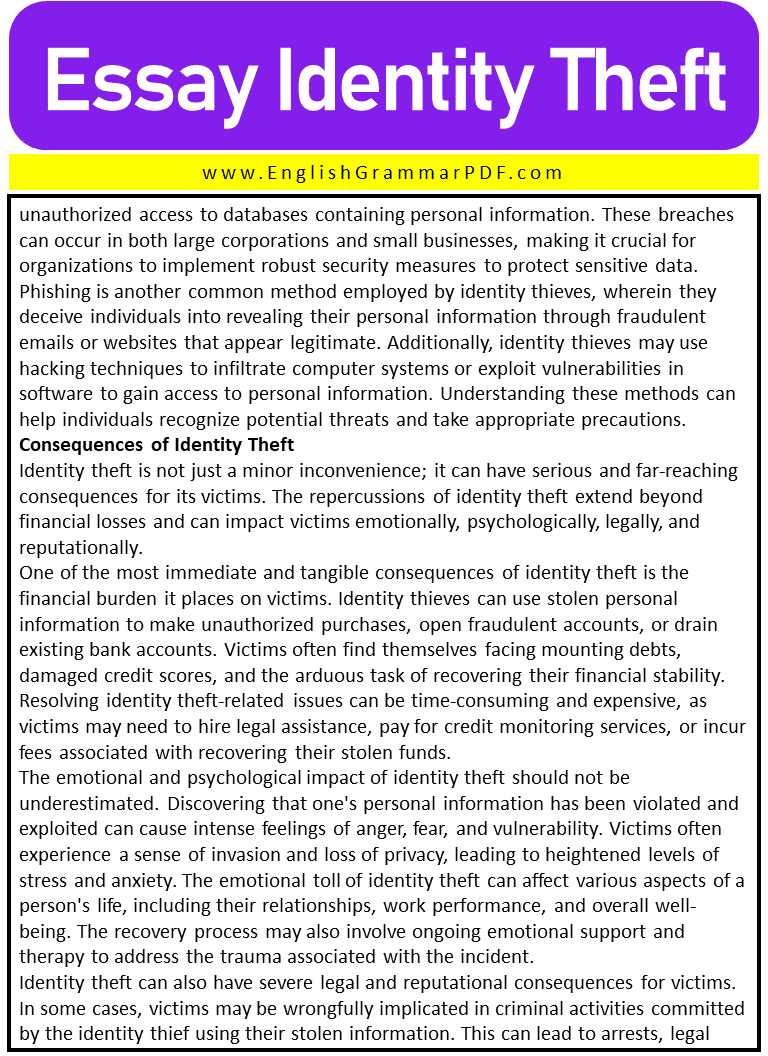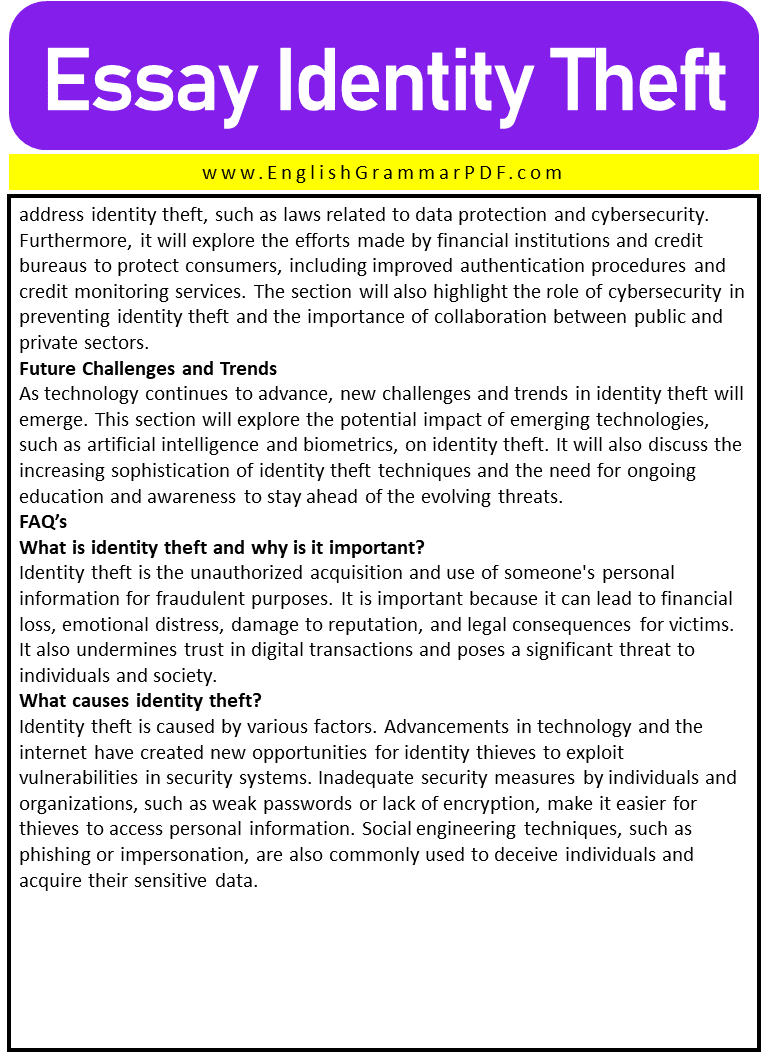Identity Theft Essay
Outline of Essay:
- Introduction
- Understanding Identity Theft
- Consequences of Identity Theft
- Factors Contributing to Identity Theft
- Protecting Against Identity Theft
- Government and Corporate Responses
- Future Challenges and Trends
Introduction
Identity theft is a pervasive issue in the digital age, with serious consequences for individuals and society as a whole. This essay aims to explore the various aspects of identity theft, including its definition, prevalence, and significance. The structure of the essay will follow a logical flow, starting with an understanding of identity theft and its different forms, moving on to the consequences faced by victims, examining the contributing factors, discussing measures to protect against identity theft, exploring the responses from governments and corporations, analyzing case studies, and finally, discussing future challenges and trends in the field.
Understanding Identity Theft
Identity theft is a pervasive and rapidly growing issue in the digital age. It involves the unauthorized acquisition and use of someone’s personal information for fraudulent purposes. To effectively combat this crime, it is essential to have a comprehensive understanding of identity theft, including the types of personal information targeted, the methods employed by identity thieves, and the common motives behind these actions.
Firstly, identity thieves target a wide range of personal information. This includes sensitive data such as Social Security numbers, credit card details, bank account information, and online account credentials. By obtaining these pieces of information, identity thieves gain the means to assume another person’s identity, access financial resources, and engage in fraudulent activities. It is crucial for individuals to be aware of the various types of personal information at risk and to take steps to safeguard them.
Secondly, identity thieves utilize a variety of methods to acquire personal information. One prevalent method is through data breaches, where hackers gain unauthorized access to databases containing personal information. These breaches can occur in both large corporations and small businesses, making it crucial for organizations to implement robust security measures to protect sensitive data. Phishing is another common method employed by identity thieves, wherein they deceive individuals into revealing their personal information through fraudulent emails or websites that appear legitimate. Additionally, identity thieves may use hacking techniques to infiltrate computer systems or exploit vulnerabilities in software to gain access to personal information. Understanding these methods can help individuals recognize potential threats and take appropriate precautions.
Consequences of Identity Theft
Identity theft is not just a minor inconvenience; it can have serious and far-reaching consequences for its victims. The repercussions of identity theft extend beyond financial losses and can impact victims emotionally, psychologically, legally, and reputationally.
One of the most immediate and tangible consequences of identity theft is the financial burden it places on victims. Identity thieves can use stolen personal information to make unauthorized purchases, open fraudulent accounts, or drain existing bank accounts. Victims often find themselves facing mounting debts, damaged credit scores, and the arduous task of recovering their financial stability. Resolving identity theft-related issues can be time-consuming and expensive, as victims may need to hire legal assistance, pay for credit monitoring services, or incur fees associated with recovering their stolen funds.
The emotional and psychological impact of identity theft should not be underestimated. Discovering that one’s personal information has been violated and exploited can cause intense feelings of anger, fear, and vulnerability. Victims often experience a sense of invasion and loss of privacy, leading to heightened levels of stress and anxiety. The emotional toll of identity theft can affect various aspects of a person’s life, including their relationships, work performance, and overall well-being. The recovery process may also involve ongoing emotional support and therapy to address the trauma associated with the incident.
Identity theft can also have severe legal and reputational consequences for victims. In some cases, victims may be wrongfully implicated in criminal activities committed by the identity thief using their stolen information. This can lead to arrests, legal charges, and the need to prove their innocence, which can be an arduous and costly process. Moreover, victims may suffer damage to their personal and professional reputation. For instance, if an identity thief uses a victim’s identity to engage in fraudulent activities, it can tarnish the victim’s image and credibility. Rebuilding trust and restoring one’s reputation can be an uphill battle that requires time, effort, and resources.
Furthermore, identity theft can have a long-lasting impact on victims’ lives. Even after resolving the immediate consequences, individuals may find it challenging to regain their sense of security and trust in the digital world. The fear of being targeted again can linger, leading to a loss of confidence in conducting online transactions or sharing personal information. Victims may become more cautious and skeptical, potentially limiting their ability to engage in various aspects of modern life that heavily rely on digital technologies.
Factors Contributing to Identity Theft
Identity theft has been facilitated by various factors, which will be explored in this section. The advancements in technology and the internet have provided identity thieves with new opportunities and tools for their activities. Additionally, inadequate security measures implemented by individuals and organizations, such as weak passwords and outdated software, contribute to the vulnerability of personal information. The section will also delve into the social engineering techniques employed by identity thieves to manipulate individuals into revealing their sensitive information.
Protecting Against Identity Theft
Given the growing threat of identity theft, individuals need to take proactive measures to protect their personal information. This section will discuss strategies for safeguarding personal information, including proper handling and disposal of sensitive documents, the use of strong passwords and encryption methods, and the adoption of secure online browsing habits. It will also emphasize the importance of recognizing and avoiding common scams and phishing attempts, as well as the significance of monitoring and reporting any suspicious activities promptly.
Government and Corporate Responses
Governments and corporations play a crucial role in combating identity theft. This section will examine the legislative and regulatory measures implemented to address identity theft, such as laws related to data protection and cybersecurity. Furthermore, it will explore the efforts made by financial institutions and credit bureaus to protect consumers, including improved authentication procedures and credit monitoring services. The section will also highlight the role of cybersecurity in preventing identity theft and the importance of collaboration between public and private sectors.
Future Challenges and Trends
As technology continues to advance, new challenges and trends in identity theft will emerge. This section will explore the potential impact of emerging technologies, such as artificial intelligence and biometrics, on identity theft. It will also discuss the increasing sophistication of identity theft techniques and the need for ongoing education and awareness to stay ahead of the evolving threats.
FAQ’s
What is identity theft and why is it important?
Identity theft is the unauthorized acquisition and use of someone’s personal information for fraudulent purposes. It is important because it can lead to financial loss, emotional distress, damage to reputation, and legal consequences for victims. It also undermines trust in digital transactions and poses a significant threat to individuals and society.
What causes identity theft?
Identity theft is caused by various factors. Advancements in technology and the internet have created new opportunities for identity thieves to exploit vulnerabilities in security systems. Inadequate security measures by individuals and organizations, such as weak passwords or lack of encryption, make it easier for thieves to access personal information. Social engineering techniques, such as phishing or impersonation, are also commonly used to deceive individuals and acquire their sensitive data.
Explore More Essays:
Goals On Personal Development Essay
Download the PDF of Essay







